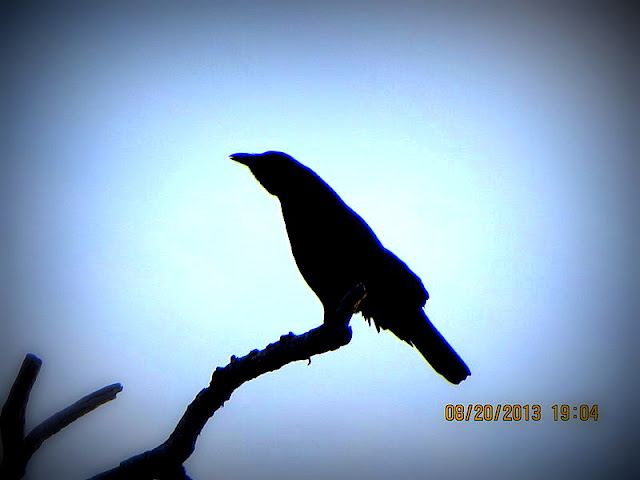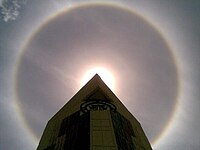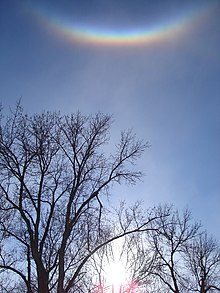Hi Everybody:
Once in a Blue Moon is a phrase that refers to something occurring very rarely. In celebration of this rare occasion, I thought we would look at some other Optical Phenomena as well. Included in the info is a list of Atmospheric Optical Phenomena so You can test your own knowledge of rare events and update yourself if needed! If anyone knows them all, You get a million gold stars! Your photostudy is my old crowing crow as he is crowing and the Sun Halo that came my way, with a few hummers added. Enjoy!
From GOOGLE SEARCH:
Blue moon - Wikipedia, the free encyclopedia
en.wikipedia.org/wiki/Blue_moon
I Lomo-ed the Crow in Picasa!
Lomo-ish is an effect in Picasa Editing Program (and others have it also). Lomo is a type of effect achieved through Lomo Photography. Below is an excerpt from Wikipedia explaining Lomography:
http://en.wikipedia.org/wiki/Lomography
Lomography
From Wikipedia, the free encyclopedia
History
Lomography is a community of Lomographic photographers who advocate creative and experimental film photography. The name is inspired by the former state-run optics manufacturer LOMO PLC of Saint Petersburg, Russia that created and produced the 35 mm LOMO LC-A Compact Automat camera, now the centerpiece of the Lomographic movement. This camera was loosely based upon the Cosina CX-1 and introduced in the early 1980s.[2]
Lomography also represents the commercial trademark of Lomographische AG, an Austrian company that produces cameras and other tools that cater to the needs of this photographic movement. The society is headquartered in Vienna, Austria, where most of its events are organised.[3]
In 1991, a group of Viennese students discovered the Lomo LC-A and were "charmed by the unique, colorful, and sometimes blurry" images that the camera produced.[4] The Lomographic Society International was subsequently founded in 1992.[5] After a series of international art exhibitions culminating in exhibitions in New York City and Moscow,[5] Lomography signed an exclusive distribution agreement with LOMO PLC in 1995 — thereby becoming the sole distributor of all Lomo LC-A cameras outside of the former Soviet Union.[6] The new company reached an agreement with the deputy mayor of St Petersburg, the future Russian Prime Minister and President, Vladimir Putin, to receive a tax break in order to keep the LOMO factory in the city open.[5]
Since the introduction of the original Lomo LC-A, Lomography has produced and marketed an entire line of their own analog cameras. Most Lomographic cameras are designed to produce photographic effects such as "oversaturated colors, extreme optical distortions, rainbow-colored subjects, off-kilter exposure, blurring and alternative film processing, all things usually considered bad in photography."[7] For example, the Lomography Fisheye camera features a built-in wideangle lens, and shoots fisheye-distorted photos. In 2005, production of the original Lomo LC-A was discontinued. Its replacement, the Lomo LC-A+, was introduced in 2006. The new camera, made in China rather than Russia, featured the original Russian lens manufactured by LOMO PLC.[8] This changed as of mid-2007 with the lens now made in China as well.
Similar to Eastman Kodak's concept of the "Kodak moment", the philosophy behind Lomography is summarized in its motto, "Don’t Think, Just Shoot."[5] This motto is accompanied by The Ten Golden Rules which are supposed to encourage spontaneity, odd angles, and taking photos anywhere, while minimizing considerations of formal technique.[9] Typical Lomography cameras are deliberately low-fidelity and constructed to make sure their mechanics are not too technical. Some cameras make use of multiple lenses and rainbow-colored flashes, or exhibit extreme optical distortions and even light leaks.[10] In November 2012, the Lomographic Society International celebrated its 20th anniversary. The LC-A+ camera was re-released as a special edition and the online magazine section ran articles about some of the best lomographic shots of the last 20 years. In addition to that, a microsite was set up, highlighting some of the company's most well-known releases and stunts
Please see link for complete article
A Few Hummers today:
This is a male juvenile who is just getting his first red feathers
I had a Sun Halo:
http://en.wikipedia.org/wiki/Halo_(optical_phenomenon)
Halo (optical phenomenon)
From Wikipedia, the free encyclopedia
A halo (from Greek ἅλως; also known as a nimbus, icebow or gloriole) is an optical phenomenon produced by ice crystals creating colored or white arcs and spots in the sky. Many are near the sun or moon but others are elsewhere and even in the opposite part of the sky. They can also form around artificial lights in very cold weather when ice crystals called diamond dust are floating in the nearby air.
There are many types of ice halos. They are produced by the ice crystals in cirrostratus clouds high (5–10 km, or 3–6 miles) in the upper troposphere. The particular shape and orientation of the crystals is responsible for the type of halo observed. Light is reflected andrefracted by the ice crystals and may split up into colors because of dispersion. The crystals behave like prisms and mirrors, refracting and reflecting sunlight between their faces, sending shafts of light in particular directions.
Atmospheric phenomena such as halos were used as part of weather lore as anempirical means of weather forecasting before meteorology was developed. They often do mean that rain is going to fall within the next 24 hours as the cirrostratus clouds that cause them can signify an approaching frontal system.
Other common optical phenomena involving water droplets rather than ice crystals include the glory and the rainbow.
http://en.wikipedia.org/wiki/Atmospheric_phenomenon
Optical phenomenon
From Wikipedia, the free encyclopedia
(Redirected from Atmospheric phenomenon)
An optical phenomenon is any observable event that results from the interaction of light and matter. See also list of optical topics and optics. A mirage is an example of an optical phenomenon.
Common optical phenomena are often due to the interaction of light from the sun or moon with the atmosphere, clouds, water, dust, and other particulates. One common example is the rainbow, when light from the sun is reflected and refracted by water droplets. Some, such as the green ray, are so rare they are sometimes thought to be mythical.[1] Others, such as Fata Morganas, are commonplace in favored locations.
Other phenomena are simply interesting aspects of optics, or optical effects. The colors generated by a prism are often shown in classrooms, for instance.
A list of optical phenomena
Optical phenomena include those arising from the optical properties of the atmosphere; the rest of nature (other phenomena); ofobjects, whether natural or human-made (optical effects); and of our eyes (Entoptic phenomena). Also listed here are unexplained phenomena that could have an optical explanation and "optical illusions" for which optical explanations have been excluded.
There are many phenomena that result from either the particle or the wave nature of light. Some are quite subtle and observable only by precise measurement using scientific instruments. One famous observation is of the bending of light from a star by theSun observed during a solar eclipse. This demonstrates that space is curved, as the theory of relativity predicts.
Atmospheric optical phenomena
- Afterglow
- Airglow
- Alexander's band, the dark region between the two bows of a double rainbow.
- Alpenglow
- Anticrepuscular rays
- Auroral light (northern and southern lights, aurora borealis and aurora australis)
- Belt of Venus
- Blue Flash
- Blue moon
- Circumzenithal arc
- Crepuscular rays
- Earthquake lights
- Earth's shadow
- Glories (also known as Brocken's Specter or Specter of the Brocken)
- Green Flash
- Halos, of Sun or Moon, including sun dogs
- Heiligenschein or halo effect, partly caused by the Opposition effect
- Cloud iridescence
- Light pillar
- Rainbows
- Sundogs
- Mirages (including Fata Morgana)
- Shadow set
- Tyndall effect
Other optical phenomena
Optical effects
- Asterism, star gems such as star sapphire or star ruby.
- Aura, a phenomenon in which gas or dust surrounding an object luminesces or reflects light from the object.
- Aventurescence, also called the Schiller effect, spangled gems such as aventurine quartz and sunstone.
- The camera obscura
- Caustics
- Chatoyancy, cat's eye gems such as chrysoberyl cat's eye or aquamarine cat's eye
- Chromatic polarization
- Cathodoluminescence
- Diffraction, the apparent bending and spreading of light waves when they meet an obstruction.
- Dispersion
- Double refraction or birefringence of calcite and other minerals
- The Double-slit experiment
- Electroluminescence
- Evanescent wave
- Fluorescence, also called luminescence or photoluminescence.
- Phosphorescence
- Mie scattering (Why clouds are white)
- Metamerism as of alexandrite
- Moire
- Newton's rings
- Pleochroism gems or crystals, which seem many-colored
- Polarized light-related phenomena such as double refraction, or Haidinger's brush
- Rayleigh scattering (Why the sky is blue, sunsets are red, and associated phenomena)
- Refraction
- Sonoluminescence
- Synchrotron radiation
- The separation of light into colors by a prism
- Triboluminescence
- The Zeeman effect
- Thomson Scattering
- Total internal reflection
- Twisted light
- The Umov effect
- The ability of light to travel through space or through a vacuum.
Entoptic phenomena
Main article: Entoptic phenomenon
- Diffraction of light through the eyelashes
- Haidinger's brush
- Monocular diplopia (or polyplopia) from reflections at boundaries between the various ocular media
- Phosphenes from stimulation other than by light (e.g., mechanical, electrical) of the rod cells and cones of the eye or of other neurons of the visual system
- Purkinje images.
Optical illusions
Main article: Optical illusion
sun rays from the sun
- The unusually large size of the Moon as it rises and sets, the moon illusion
- The shape of the sky, the sky bowl
Unexplained phenomena
See also: Forteana, Will-o'-the-wisp, and Unidentified flying object
Some phenomena are yet to be conclusively explained and may possibly be some form of optical phenomena. Some[weasel words]consider many of these "mysteries" to simply be local tourist attractions that are not worthy of thorough investigation.[3]
http://en.wikipedia.org/wiki/AnthelionAnthelion
From Wikipedia, the free encyclopedia
An anthelion (plural anthelia, from late Greek ανθηλιος, "opposite the sun") is a rare optical phenomenon appearing on theparhelic circle opposite to the sun as a faint white halo, not unlike a sundog.
How anthelions are formed is disputed. Walter Tape, among others, has argued they are not separate haloes, but simply where various haloes caused by horizontally oriented column-shaped ice crystals coincide on the parhelic circle to create a bright spot. If this theory is correct, anthelia should only appear together with these other haloes.[1]
However, anthelia occur unaccompanied by other plate crystal haloes, thus scientists have produced alternative explanations. The Dutch professor S.W. Visser proposed they form by two exterior light reflections in quadrangular prisms, while Robert Greenler has suggested two interior reflection in column-shaped crystals produces the phenomenon.[1]
While the anthelion area is usually sparse on haloes, in a complex display it features various rare optic phenomena: Flanking the anthelion on the parhelic circle are two 120° parhelia (and two Liljequist parhelia) caused by plate crystals. The Tricker and diffuse arcsare produced in singly oriented column crystals and form an Ankh-like shape passing through the anthelion. Wegener arcs occasionally crosses the sky to converge in the anthelion.[2]
Please see above link to view complete page
...this is brendasue signing off from Rainbow Creek. See You next time. (From the top of the Stairway to Heaven, this is the view in summer):Please see above link to view complete page

Last but not least, a secret hiding place for Rascal Roo!
O+O




























































No comments:
Post a Comment
Hi Everybody! Please say hello and follow so I know you are here! Due to the inconsideration of people trying to put commercials on my blog comment area, I have restricted use of anonymous posts. Sorry that some hurt all.
My public email is katescabin@gmail.com No spammers or trolls